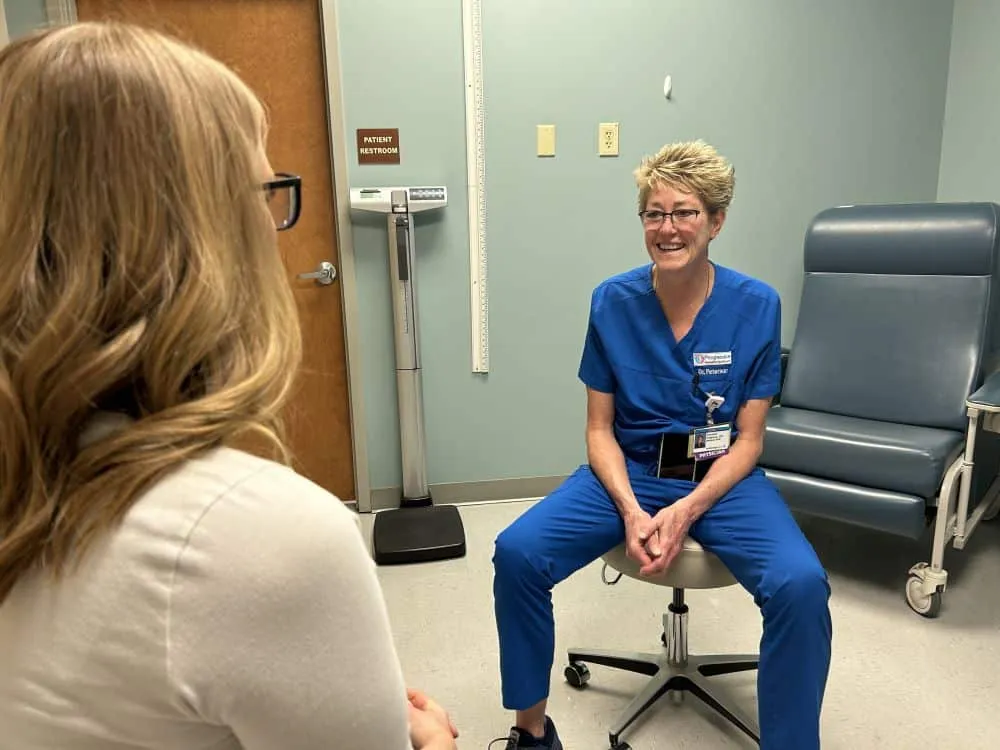Women’s Health
Want to learn more about this at Kettering Health?
Infertility is a silent condition. It’s confusing, costly, and heartbreaking—like many diagnoses. But unlike other conditions in which someone “has” something they’d never want, infertility is marked by “not having” something hoped for.
After more than 30 years as an OB-GYN, Dr. Caroline Peterson has seen countless women live under the quiet, stifling weight of infertility. And she’s helped just as many find clarity, receive reassurance, and welcome their family’s newest member.
But over the years, Dr. Peterson has watched one particularly elusive issue complicate matters for women facing infertility: Endometriosis.
“And for nearly 50% of women with infertility,” Dr. Peterson says, “it’s the root cause.”
What 4 million women have in common
Dr. Peterson is familiar with the concerns and questions women often have when they come to see her. In fact, Dr. Peterson actually treats the most patients with endometriosis in this part of the country.
Throughout the U.S., it’s estimated that 4.1 million women—ranging in age from late teens to those in their 40s—have endometriosis.
And for most of those 4.1 million women, their unique experiences share common threads of feeling overlooked while living with severe pain.
Endometriosis is essentially uterine tissue gone rogue. In other words, tissue that’s typically found in the lining of the uterus (endometrium) shows up (or implants) elsewhere. It can end up on the ovaries, in the fallopian tubes, even on the lining of the lungs and heart. Experts still don’t know what causes it.
But if it implants in the pelvic cavity (which holds the bladder, colon, and internal reproductive organs), it can lead to severe pelvic pain and infertility.
How it affects fertility
When endometrial tissue implants on the fallopian tubes, it scars them. And the worse the scarring, the more difficult the passage is for any eggs and sperm. Endometriosis has four stages—four being the most severe.
But even at stage one, endometriosis can lead to infertility. Not only does the scarring cause problems for eggs and sperm, but the implants of endometrial tissue also become a target of a woman’s immune system.
“Even for women with stages one, two, and three, their bodies get so busy fighting off this other disease,” says Dr. Peterson. “And when women’s bodies and immune systems are that depleted, it’s tough to get pregnant.”
But once it’s diagnosed and treated, for many women, “they can conceive naturally.”
Dr. Peterson says the two main ways to diagnose and treat endometriosis are
- Laparoscopy: A minimally invasive procedure using a thin lighted tube with a camera (laparoscope) to check organs around the abdomen. Dr. Peterson says this is the “gold standard for diagnosis.”
If endometriosis is found, particularly in the first three stages, it’s removed painlessly with a surgical laser. For stage 4 cases, “we clean it up with the laser to improve outcomes,” Dr. Peterson says. “And then we often go to infertility specialists for assisted reproductive help.”
- Clinical evaluation: A physician evaluates symptoms and lifestyle factors to determine the likelihood of endometriosis. Dr. Peterson points out that “several medical associations acknowledge this is acceptable for diagnosis.”
Treatment often involves hormones and additional medicine.
But with clinical evaluation, Dr. Peterson admits there are vulnerabilities. Because endometriosis is difficult to diagnose without seeing it, and it’s often not considered as a reason for symptoms early on, clinical evaluations can be where women encounter more challenges along with infertility.
As if infertility weren’t hard enough
Endometriosis is too small to spot in scans, such as MRIs, CT scans, and ultrasounds. And with its array of possible symptoms—severe pelvic pain, especially during sex and menstrual cycles; bladder and bowel issues; fatigue and depression—women who seek help often have difficulty finding it.
Dr. Peterson shared that among women with endometriosis,
- 58% reported seeing three or more physicians before receiving a diagnosis.
- 63% reported that at least one physician told them nothing was wrong.
- Nearly 60% reported they weren’t taken seriously by a physician.
On top of physical and emotional pain, women with endometriosis often have to navigate the mental strain of feeling overlooked and discredited—while being at a loss for where to find help. And that can quickly lead to stopping any search for answers.
“Nobody wants to be told that what they’re feeling and experiencing on a day-to-day basis is nothing,” says Dr. Peterson. “That can be disempowering to a person.”
All this leads to delays in diagnosis. In fact, for women with endometriosis, delays in diagnosis can span from two to six years. Sometimes even a decade. Delays also include misdiagnosis.
“Because of the symptoms,” Dr. Peterson says, “70% of women with endometriosis will be diagnosed with and treated for irritable bowel syndrome when, in fact, it’s endometriosis.”
What’s needed, Dr. Peterson points out, is a shift in improving how promptly endometriosis is diagnosed. And for more patient-focused resources to “empower young women that something could be wrong.”
Helping women heal—and feel heard
Dr. Peterson has shown how effective this approach is to improving patients’ health. She and Sarah King, her nurse practitioner, developed a study and resulting questionnaire for new patients who come to her looking for answers.
Patients answer five questions to help Dr. Peterson and her colleagues understand a patient’s likelihood for endometriosis. Doing so also helps give voice to a woman’s experiences with symptoms, which helps open the door to productive conversations about their health early on.
“We don’t want to wait and work back from infertility. We use the questionnaire to work forward. And after two years of our study, we found that 100% of women who were indicated by the questionnaire as having endometriosis actually had it, which was verified at laparoscopy.”
This has since led to more women getting answers and their confidence back through successful diagnosis and treatment.
And oftentimes welcoming their long-awaited something hoped for.












